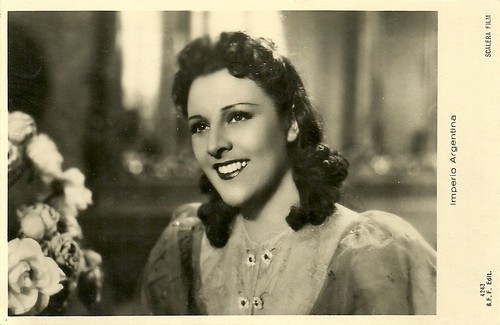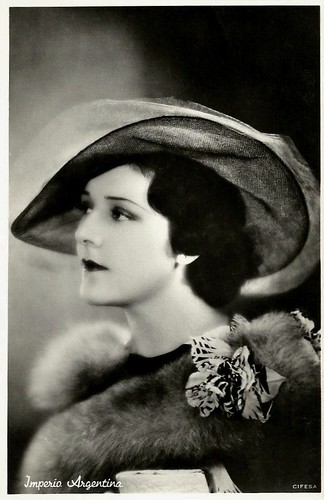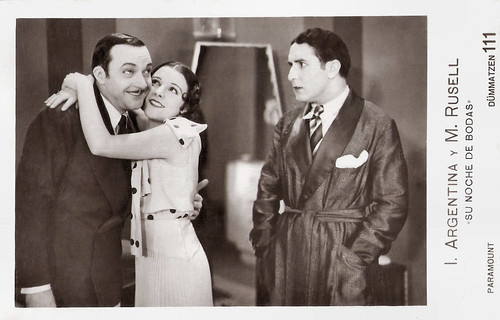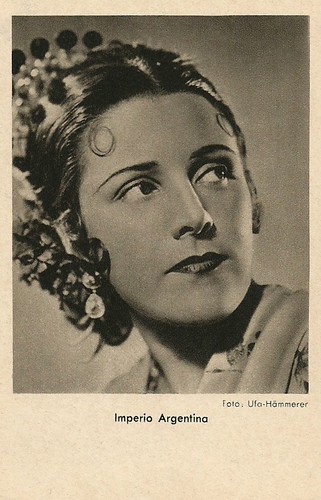But the leading role of Tosca was played by only one person, the enigmatic Imperio Argentina (1906-2003). Although the famous actress and singer was born in Buenos Aires, Argentina was successful all over South America and worked in Spain, France, Italy and Germany, she was a Spanish citizen.

Italian postcard by Ballerini & Fratini Firenze Editori, no. 4248. Photo: Scalera Film. Imperio Argentina in Tosca (Carl Koch, 1941).

Dutch postcard by M. B. & Z. (M. Bonnist & Zonen, Amsterdam), no. 199. Photo: Cifesa (Cifesa was a big Spanish film distribution company between the mid-1930s and the early 1960s.)

Latvian postcard by EMBR, no. 3131. Photo: Ufa. Imperio Argentina in Carmen (la de Triana)/Andalusisches Nächte (Florián Rey, 1938).
Petite Imperio
Imperio Argentina was born Magdalena Nile del Río in 1906 in San Telmo, the Tango district of Buenos Aires. Her Spanish parents, guitar player Antonio Nile and actress Rosario del Río, were on tour in Argentine. Until the age of 12, she lived in Malaga, where she studied dance. Thanks to Pastora Imperio, she debuted at the age of 12 at the comedy theatre of Buenos Aires. Imperio called her 'Petite Imperio', her artistic name in those years, when she was successful all over South America.
When she came back to Spain in 1926, she adopted the artistic name of Imperio Argentina, singing in the main theatres of the country. Film director Florián Rey discovered her at the Romea Theatre in Madrid and enabled her to play in the silent film La Hermana San Sulpicio/Sister San Sulpicio (Florián Rey, 1927). Eventually, she also married Rey, who was the first of her three husbands. In Spain and Germany, Argentina performed in the late silent film Corazones sin rumbo/Herzen ohne Ziel/Hearts Without Soul (Benito Perojo, Gustav Ucicky, 1928), which costarred Betty Bird and Livio Pavanelli.
After signing a contract with Paramount Pictures, she worked in Paris with the best directors and actors of the moment. Her films included Su noche de bodas/Her Wedding Night (Louis Mercanton, Floriàn Rey, 1931) and Lo mejor es reir/Laughter (E.W. Emo, Floriàn Rey, 1931) with Tony D'Algy. At Paramount she worked with Carlos Gardel in the short La casa es seria/Love Me Tonight (Lucien Jacquelux, 1931), which is considered as lost, and Melodía de Arrabal/Suburban Melody (Louis Gasnier, 1932), singing rare duets with him.
In 1934 Argentina returned to Spain, where, thanks to her cooperation with Rey, she became a star and obtained her greatest successes in folklorist films as the sound version of Hermana de San Sulpicio/Sister San Sulpicio (Floriàn Rey, 1934), Nobleza Baturra/Aragonese Virtue (Floriàn Rey, 1935), and Morena Clara/Dark and Bright (Floriàn Rey, 1936).
Adolf Hitler asked her to play in a film about Lola Montes, which she declined but instead, she played in both the Spanish and the German version of Carmen, la de Triana/Andalusische Nächte (Florian Rey, Herbert Maisch, 1938), shot around Malaga. In the German version, Friedrich Benfer (a.k.a. Enrico Benfer) costarred as Don José, while in the Spanish version, Rafael Rivelles played this part. Imperio Argentina is said to have had an affair with Rafael Rivelles before she divorced her second husband Ramón Baillío. Her divorce caused a scandal, as she was married for the Catholic church.

Spanish postcard by Dümmatzen, no. 111. Photo: Paramount. Imperio Argentina, Manuel Russell and Pepe Romeu in Su noche de bodas/Her Wedding Night (Louis Mercanton, Florián Rey, 1931).

German postcard by Ross Verlag. Photo: Knevels-Film. Imperio Argentina, wearing the attire of La canción de Aixa/Song of Aixa (Florián Rey, 1939).

German postcard. Photo: Ufa / Hämmerer.
Paseo de la Fama
In 1940 Imperio Argentina travelled to Rome to star opposite Rossano Brazzi in Tosca/The Story of Tosca (Carlo a.k.a. Carl Koch, 1941), an adaptation of the story by Victorien Sardou. The film was originally directed by Jean Renoir, but when war between France and Italy was at hand and Renoir was knocked down by fascists one day, he fled to France and his assistant Carl Koch took over directing.
In his memoirs, Michel Simon, who played her antagonist Scarpia in the film, recalls how he rehearsed the rape scene of Tosca too vividly, unveiling one of her breasts. Fascinated, he tried the same the next day, but Imperio had taken measures, firmly tying up her robe. The film was partly shot on location, at the Castel Sant’Angelo, the Palatine Hill and in front of the Palazzo Farnese (the French embassy). A young Luchino Visconti collaborated as a first assistant and learned the tricks of the trade here.
In the 1940s, Imperio also worked with director Benito Perojo on the films Goyescas (1942), Bambú/Bamboo (1945), La maja de los cantares/The Songstress (1946) and La copla de la Dolores/Song of Dolores (1951) with Lola Beltrán. In the 1950s she focused on big musical shows while in the 1960s she did Ama Rosa (León Klimovsky, 1960) and Con el viento Solano/With the East Wind (Mario Camus, 1966) as the mother of Antonio Gades. After years of little activity, she was rediscovered at Festival Internacional de Cine in San Sebastián. From then on a new golden age started, full of honours.
Argentina became a citizen of Spain in 1999. In the following decades, she appeared in Tata Mía/Dear Nanny (José Luis Borau, 1986) opposite Carmen Maura and in El polizón de Ulises/The Stowaway of the Ulises (Javier Aguirre, 1987), her last film. She also performed in the stage play of the Expo 92, Azabache. In 1996 she was elected 'pregonera' at the Festa del Pilar at Saragozza, to celebrate the centenary of the cinema. In 2001 she published her memoir, 'Malena Clara', written by Pedro Villora.
At the age of 92, Imperio Argentina died of natural causes in 2003 in her house in Torremolinos in Andalucia. She lies buried nearby at Benalmádena near Málaga. In 2011 she was honoured with a star on the Spanish Walk of Fame, the Paseo de la Fama in Madrid. In 1994 she already was honoured as 'Ciudadano Ilustre de la Ciudad de Buenos Aires' (Illustrious Citizen of the City of Buenos Aires).
A scene with Imperio Argentina in Carmen la de Triana (Florían Rey, 1938) singing 'Los piconeros'. Source: Canta Roable (YouTube).
Long scene from Tosca/The Story of Tosca (Carl Koch, 1941). Source: Otello Bailor (YouTube).
Sources: Miguel A. Andrade (IMDb), Wikipedia (English, German, Italian and Spanish), and IMDb.
This post was last updated on 22 April 2023.
No comments:
Post a Comment